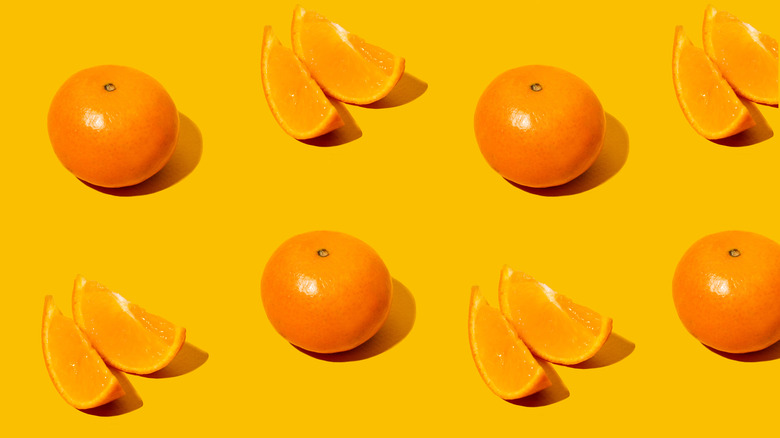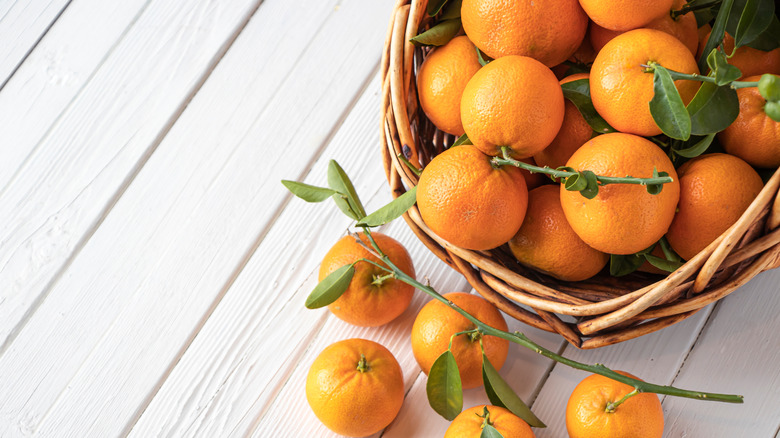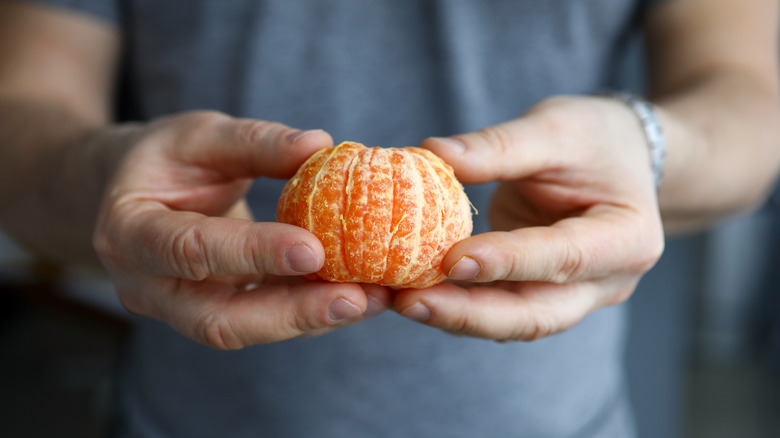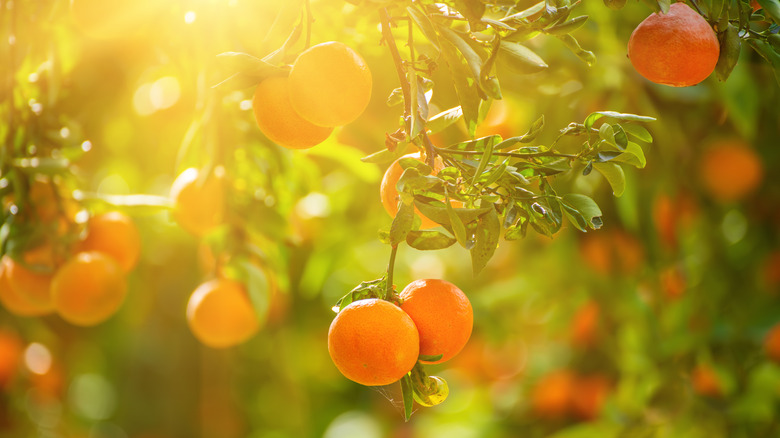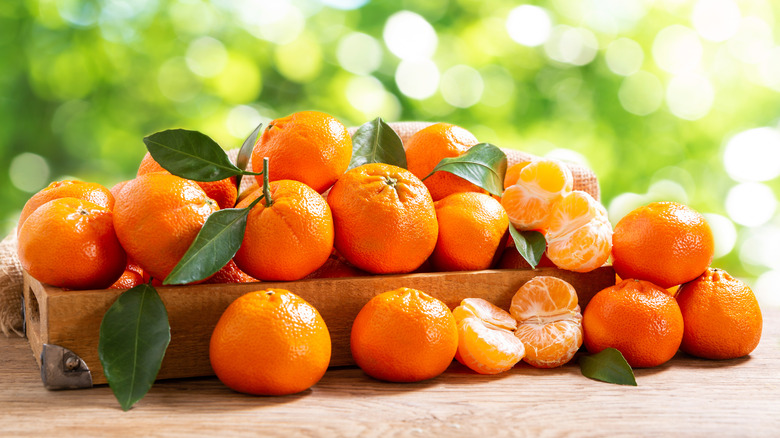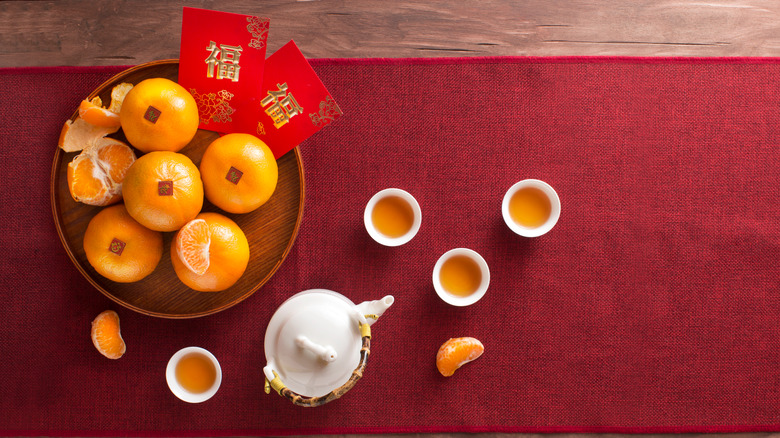What Are Mandarin Oranges And Are They More Nutritious Than Regular Oranges?
Much like apples, there are many varieties of oranges which makes orange shopping particularly difficult. While it's fairly easy to discern a regular orange from other varieties, things get confusing when you get down to the oranges that are smaller in size which all start to look similar to each other.
Mandarin oranges are similar in appearance to both tangerines and clementines due to their shape and size. However, mandarin oranges are a different type of citrus fruit altogether. According to Healthline, although mandarin oranges do belong to the citrus family of fruits, they are a completely different type of citrus fruit to oranges. While mandarin oranges are scientifically called Citrus reticulate, other oranges belong to the Citrus sinensis group of citrus fruits. For this reason, the website says that mandarin oranges are often referred to only as mandarins.
Mandarins are native to Asia, with China being one of the biggest suppliers of the fruit (via The Spruce Eats). Mandarins grow well in warm and sunny weather and are primarily grown in California in the U.S. However, different varieties of mandarins can be grown in different countries and a range of climatic conditions.
What are mandarin oranges?
Although mandarins are considered to be a type of orange, that isn't necessarily the case. Instead, mandarins are used as hybrids with a variety of citrus fruits to cultivate other varieties of oranges (via Healthline). It is estimated that mandarins are used to grow about 162 to 200 varieties of hybrids, including clementines and tangerines.
Mandarins are smaller in size than regular oranges and have an oblong shape with a flat top and bottom instead of being round (via Pure Wow). They have very loose skin, which makes mandarins quite easy to peel. Mandarins also contain a very small number of seeds, if any at all. This is what makes the fruit such a popular snack to eat on the go. Due to their lack of seeds, mandarins are a great citrus fruit to use for baking, too.
Usually, you would find mandarins flooding the fruit and veg aisles of grocery stores from January until May. They are also available canned and as syrups all year round, however.
What do mandarin oranges taste like, and how can you use them?
Because mandarins belong to the citrus group of fruits, it may be obvious to think that mandarins have a sharp and tart flavor, but that's not the case. Mandarins are one of the sweeter kinds of citrus fruits and are less acidic than regular oranges, both contributing factors in the mandarin's popularity.
Mandarins are very easy to peel and the segments inside come off without much struggle as well. This is why mandarin segments are used as a topping for salads and desserts (via The Spruce Eats). Fresh mandarins also tend to be quite juicy so you can add a squeeze of mandarin juice to make salad dressings and sauces a touch sweeter and more flavorful. Mandarins can be found in syrup form and are often canned as well to preserve them for consumption all year round. If you'd rather not buy cans of mandarin segments, you could easily make your own batch at home using mandarins, sugar, and water. The only thing to be careful of is to not get any of the bitter white pith into the canning process, says another post at The Spruce Eats.
How nutritious are mandarin oranges?
It may be surprising just how much nutrition can be packed in such a small fruit. Mandarins can actually make up for a considerable amount of your daily recommended nutrition intake. One medium-sized mandarin can make up for 26% of the daily recommended vitamin C intake, which improves skin health and immune function, and 8% of fiber, which is great for your gut (via Healthline). Additionally, mandarins are a good source of copper, which helps with the production of red blood cells and helps absorb iron.
Mandarins are high in antioxidants and are linked to being able to reduce the risk of cancer. Apart from the benefits of vitamin C, fiber and copper, mandarins are may also reduce the possibility of kidney stones forming in your body. SFGate adds that mandarin makes up for 17% of the daily recommended vitamin A intake as well, which helps improve eyesight, lung and kidney function as well as immunity. The site adds that mandarins are a better source of nutrients than regular oranges: "because people commonly consume the whole fruit, complete with fiber and membranes, and not just the juice."
Other varieties of mandarin oranges
Here's where things start to get a bit muddled. Mandarins, clementines, tangerines, and even oranges in general, are often used interchangeably. You could be out shopping for a bag of mandarins but instead, end up with a bunch of tangerines. While clementines and tangerines are a variety of mandarins, mandarins are not a variety of clementines and tangerines.
The Spruce Eats explains that mandarins are used as a hybrid to cross-cultivate with other citrus fruits, including oranges, and that there are about 200 odd varieties of mandarins that are grown across the world. The most common variety found is tangerines. A slightly more tart and dark-colored variety of mandarin, tangerines get their name from being exported to Europe from the Moroccan city of Tangier.
Clementines are a smaller version of mandarins. Referred to as cuties or sweeties, clementines are easy to peel and seedless just like mandarins, and are preferred as snacks for kids due to their tiny size. Other varieties of mandarins include ponkan, satsuma, honey murcott, and mandelo (via The Straits Times).
Mandarin oranges have cultural significance in China
Mandarin fruit gets its name from the official language of China, Mandarin, and it has a deeply rooted symbolic meaning in the country. My Recipes says that the Chinese word for mandarin is 'kam' and 'kam' is similar in sound to the Chinese word for gold. As a consequence, mandarins are a Chinese symbol of wealth.
During Chinese New Year, a red envelope filled with cash is customarily exchanged between friends, family, and loved ones. Along with the shiny red envelope, some people also hand over a mandarin on top. However, the website notes that it's not just any ordinary mandarin that is handed over to people as a symbol of good fortune; it's only mandarins with their stems and leaves intact are deemed suitable to be presented as an auspicious gift, because they symbolize fertility and long life. Mandarins with stems and leaves are also used as a decorative item to give the house a festive makeover in time for the Chinese New Year.
